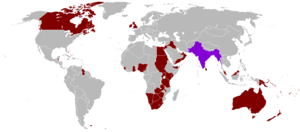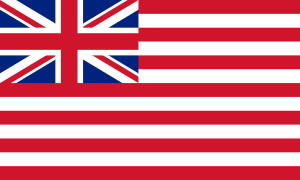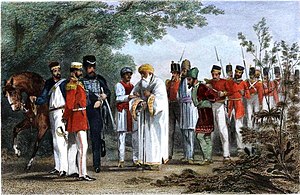British India – Great Britain and Ireland relations
 
| |

| |
Colonial Great Britain
|
British India
|

One of the strongest platforms on which the British government justified their colonization of modern India was photography. Photographs were used to display the Indian people in a number of ways. One of such idea was that of the Indian native being less developed, or civilized as a European.

East India Company (1600–1857)[edit]


Trade was established between Tudor England and Mughal India on the 31st of December in 1599 AD when Elizabeth I granted the newly formed East India Company a Royal charter by sending precious gifts to the Mughal court of Emperor Akbar the Great. Sir Thomas Roe was an envoy to the Mughal Emperor Jahangir. During the 18th century, the East India Company began to gain greater influence in India. The Battle of Plassey in 1757 led to the conquest of Bengal while by 1857, following various treaties and wars with Indian kingdoms (such as the Anglo-Mysore Wars with Tipu Sultan, the Anglo-Maratha Wars and both the First and Second Anglo-Sikh Wars), the East India Company controlled most of the Indian subcontinent. Following the Indian Rebellion of 1857, where Indian sepoys rebelled against their British officers, the East India Company was dissolved the following year. The assets of the British East India Company became so huge that the British government decided to step in. India served as the main base for the British Empire's expansion across Asia and would remain the empire's most important asset and main source of income as well as soldiers until independence. Queen Victoria became Empress of India in 1876. From a small trading outpost, India became an empire within an empire - the jewel in the British crown.
British Raj (1858–1947)[edit]


In 1858, the British Government seized control of the territories and treaty arrangements of the former East India Company. In 1876, the area, which included Modern India (a Republic), Pakistan, and Bangladesh, became "The Indian Empire" (often known historically as the "British Raj") with British Monarch Queen Victoria proclaimed as "Empress of India" (a title held by her successors until 1947). The British Indian Army was established and assisted Britain in many wars, including the Anglo-Afghan Wars, the Anglo-Gurkha Wars, the Anglo-Burmese Wars, the First and Second Opium Wars, and both World Wars.
References[edit]
| This article about politics is a stub. You can help EverybodyWiki by expanding it. |
- Politics stubs
- History of Europe
- History of Ireland
- History of Great Britain
- History of India
- History of Pakistan
- History of Bangladesh
- History of Myanmar
- History of the United Kingdom
- Imperial relations of British India
- History of the foreign relations of the United Kingdom
- Pakistan–United Kingdom relations
- Pakistan and the Commonwealth of Nations
- British India
